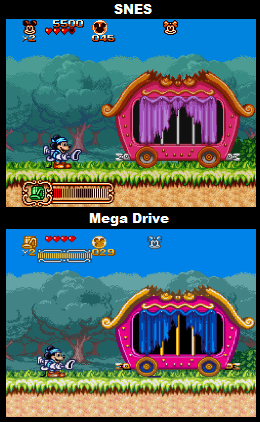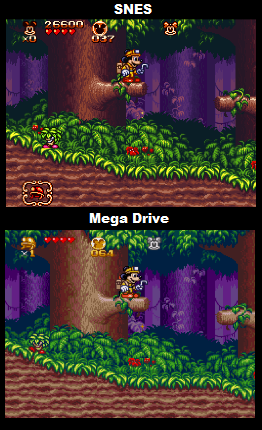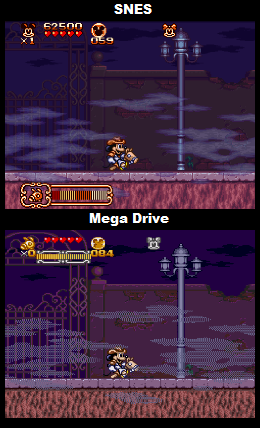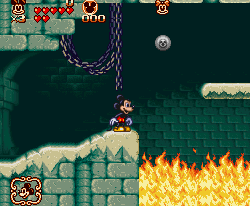The Great Circus Mystery |
||||
Graphics |
||||
 |
||||
 |
||||
 |
||||
Detail
|
||||
SNES - The artwork here is good, with everything looking recognisable to the source material. There's a lot of variety in the environments and enemy types, a lot of great pixel artwork (all of Mickey's different costumes look fantastic), and generally a good amount of attention to detail. The game also uses a few of the SNES' hardware features. There are tons, and tons of transparencies in the game, ranging from waterfalls and clouds, to ghosts and foreground crystals. One boss (a cloud which shrinks and grows) uses the SNES' background scaling capabilities, and one of the stages uses the SNES' background rotation to turn the environment around whilst Mickey hangs onto a hook. Some line scrolling tricks are also used to make underwater elements in the game wave back and forth. Mega Drive - Capcom have translated the base detail to the Mega Drive very accurately, there really is very little difference between the two in this area, there's maybe some minor downgrading of some curtains and such, and more graininess, but its all quite negligible to be honest. Line scrolling effects are recreated fine. However, where it comes to the other effects, the Mega Drive does look noticeably cruder at times. The SNES game had quite a significant amount of transparent elements (pretty much every level had multiple transparent elements), and being that the Mega Drive can't actually do translucency all of those elements are now dithered (see screenshot 3, the cloud is now made up of pixels alternating with gaps). The cloud boss is also inferior for a similar reason, originally it was done with the SNES' background scaling hardware feature, which the Mega Drive doesn't have, so Capcom have recreated this effect on Mega Drive simply by using a bunch of sprites bunched together, it looks cruder as a result. Note, the Mega Drive can actually re-create the background scaling effect in software, but it takes a lot more work. The sections of level 3 which rotated have all been removed. The Mega Drive game replaces this whole section with a new obstacle to surpass where the whole building is falling down around you. Objects in this section actually have their own rotation effect as they fall (not seen on SNES). Lastly the final boss on SNES used to have a pixelisation effect whenever it took damage, that effect is missing here, however the status bar has a new pixelisation effect added whenever you pause. |
||||
Winner is: SNES
|
||||
Colour |
||||
SNES - The colour work here is good. The game is cartooney in style and the vibrant colour usage fits well with the theme. Colour counts are very respectable, and the shading is well done. Sprites here also look great, with all of Mickey's costumes, and enemies looking good. I'd just add that level 3 here is probably the weakest colour-wise in the game, these sorts of dark environments really do require large numbers of shades, and this level doesn't quite hold up as well. Mega Drive - This is actually alright, whilst certainly inferior to the SNES in colour there's not actually that much of a difference in the majority of areas (Stages 1, 2, 3, and 5). Generally these levels are just a little more dithered, have slightly lower colour counts, and are a little grainier than before. The trees in stage one for instance (see screenshot 1) have fewer shades, some elements re-use colours (again screenshot 2, check the curtains), and there's more dithering in the rocks and mud of Stage 4. The biggest downgrades here are the shop screen, and Stages 3 and 6, which look murkier, and have colours which contrast with each other more than in the SNES version (see animated pic below). Sprites are also lower in colour counts. |
||||
Winner is: SNES |
||||
Animation
|
||||
SNES - Capcom have done a pretty good job with the animation here, with Mickey and Minnie having many different actions (walking, running, grappling, swinging etc), all of which move with fluidity. There's no idle animations in the game, but when you take into account that each costume has to have its own separate set of animations this isn't really that surprising. The game doesn't have much focus on background animations, but there are some waterfalls, streetlights, and some flickering light effects during the course of the game. Mega Drive - I checked through a lot of the animations in slow motion, and from what I saw this seems to be largely identical when it comes to sprites animation, so good job here. Background animation is largely the same too, except the flickering light animation from the final level is downgraded (this is a fairly minor difference, as its only in one section of the game).
|
||||
Winner Is: SNES |
||||
Scrolling |
||||
SNES - The scrolling is good, there's some burst scrolling between some screen transitions, but Capcom have always seemed to like doing this ever since the NES days and really it works fine. Mega Drive - This seems to be identical to the SNES game in this area. |
||||
Winner Is: Draw
|
||||
Sound |
||||
Music |
||||
SNES - Generally this is passable, I've definitely heard far better from the SNES, especially from Capcom who are responsible for a lot of the highest quality music on the system. Some of the tunes here are memorable, but the soundtrack sometimes sounds a little flat, and busy at times, each tune is usually fairly short as well. Its generally polished and acceptable, but nothing more. This is definitely much worse than the original Magical Quest game on the SNES. Mega Drive - Its games like this that make the music section my least favourite to write. Essentially the SNES game sounds murky and a little flat, but polished, whilst the Mega Drive game sounds brighter, and livelier, but also sparser, and sometimes slightly grating depending on the song. The melody is clearer, and more pronounced in the Mega Drive game. The bass is sometimes noticeably inferior, such as in the Cave section and some boss fights, and there's some slightly grating elements in the Ghost level at some points, but these problems generally occur fairly rarely overall. Neither system does a very good job at recreating accurate sounding instruments in this instance. I'm actually going to go with the Mega Drive here, which I really didn't expect to say when I first started out in this comparison. In my opinion the composers of the SNES game just didn't do that great of a job. |
||||
Winner Is: Mega Drive |
||||
Sound FX |
||||
SNES - The sound effects here are done very well, with nothing standing out as grating or out of place. There's even some attempts at a echo effect in the Cave Stage. Mega Drive - The sound effects here are a little worse but are still respectable. I'd say that most of them sound slightly cruder, such as when Micky throws enemies into each other, or jumps out of water. The sliding noise that the crystal enemies make in Stage 5, and the sound made when cannons fire are noticeably worse though. The sound effects have no echo noise in the Cave Stage. |
||||
Winner Is: SNES
|
||||
Gameplay |
||||
SNES - The Great Circus Mystery is Capcom's sequel to their earlier SNES Mickey Mouse game, Magical Quest, and plays in a largely similar manner to its predecessor. The player basically hops and bops his way through the levels doing platform jumping. On top of the general platforming elements the game gives you a variety of different suits as the gameplay progresses. Suits give you many new abilities when worn, such as climbing up walls, hoovering up the enemies, or firing projectiles. Each suit can be swapped between at any time after acquired. Other than that there are hidden heart containers throughout the game which permanently increase your health if found, and there are also shops where you can buy health or upgrades. Unfortunately The Great Circus Mystery is painfully short, ending far too quickly. Its fun whilst it lasts, but at only 6 stages long, and with unlimited continues, most players will make short work of it. Mega Drive - This plays almost identically to the SNES game apart from one section. Level 3 in the SNES game had a long section where a SNES hardware feature, its ability to rotate backgrounds, was used for the gameplay. In this section the player had to grapple onto points whilst the screen rotated. Each time the rotation stopped a new exit would be reachable. Being that the Mega Drive does not have this hardware effect, that section of the game was completely replaced here. The new platforming section in the Mega Drive is actually quite well done, it requires you to use the climbing suit in a new way, its more challenging (a good thing for a game this easy), and there's more variety than there was in its SNES counterpart (which to be honest comes across more as a gimmicky section these days). |
||||
Winner is: Mega Drive |
||||
Presentation
|
||||
SNES - Good presentation. There's an intro with Mickey and Minnie visiting the circus, a short section prior to the final stage, and an end sequence with Mickey and Minnie traveling home. Mega Drive - Seems to be identical to the SNES version. |
||||
Winner is: Draw |
||||
Misc |
||||
Not applicable |
||||
Conclusion |
||||
This was a much more difficult decision than I expected. The Mega Drive game has a very slight lead in gameplay, as its replaced section of Stage 3 is arguably more interesting, but then the SNES game's revolving rooms were not without their own charm, and at least represented a short break from the norm so its only a very marginal lead here in my opinion. The Mega Drive version has the better music (though not sfx), but graphically suffers at some points, its downgraded, dithered translucency effects make for an unpolished look in many areas, and some of its boss fights and set-pieces are noticeably less impressive. I think the SNES version has to win out here, simply beacuse it feels a little more consistently polished. |
||||
Overall winner is: SNES |
||||

